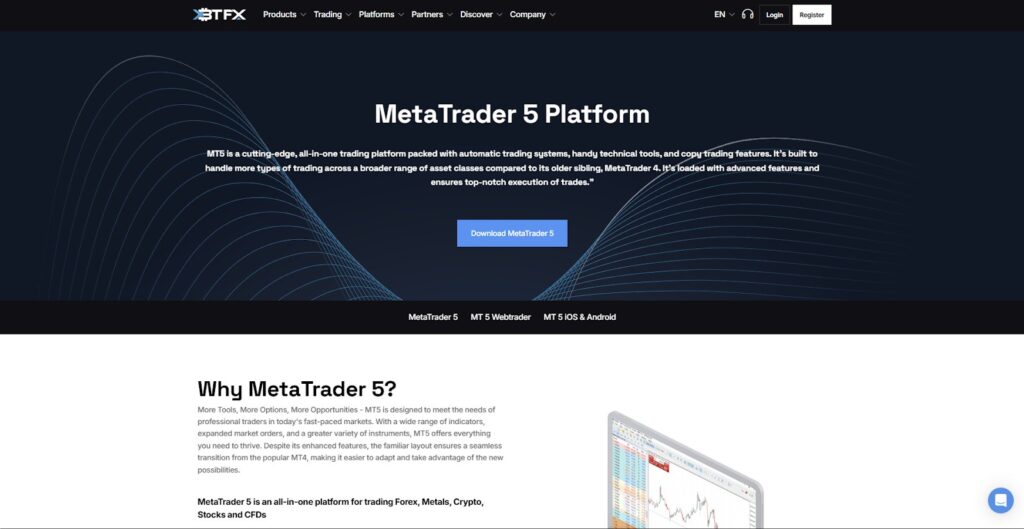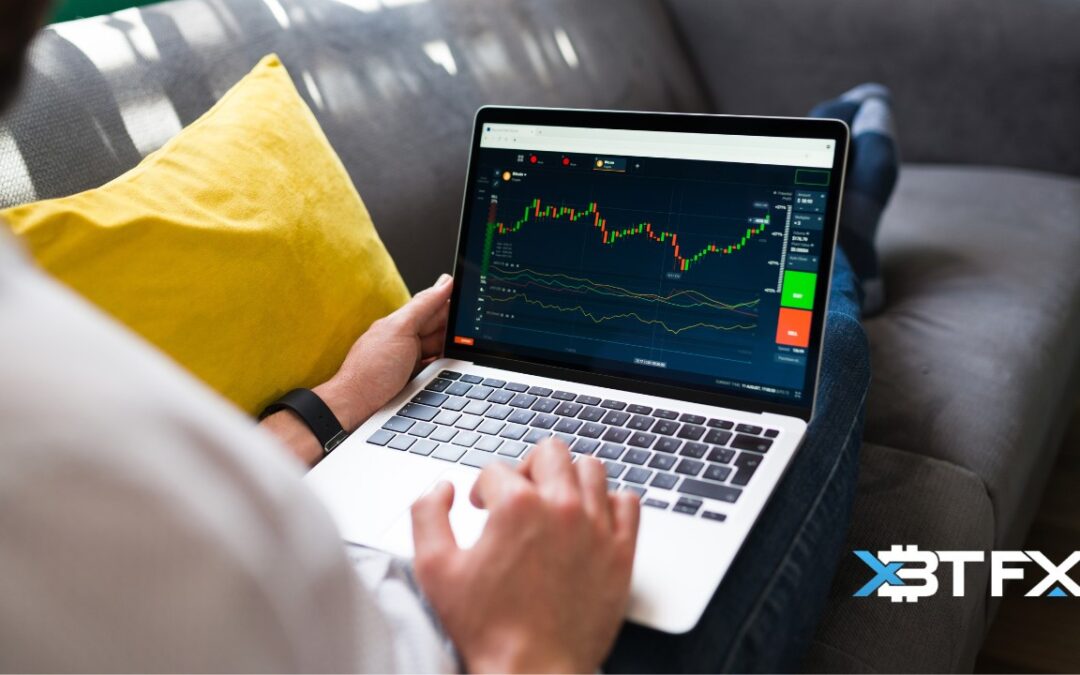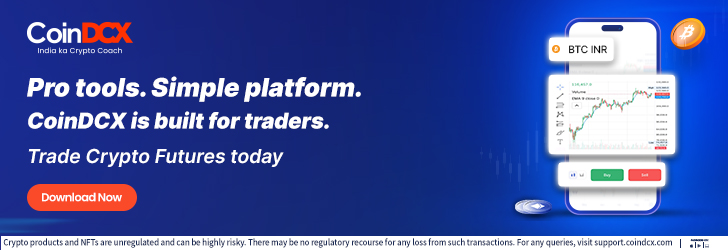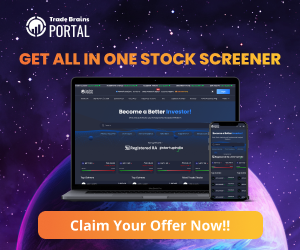With good reason, the dispute between MetaTrader 4 (MT4) and MetaTrader 5 (MT5) has sparked a lot of conversation in the online trading community. These platforms have influenced millions of trades, careers, and entire strategies. However, they are not on an equal footing.
One is a popular classic known for its unwavering simplicity that was created in the crucible of forex trading. The other is a modern powerhouse that is quicker, more intelligent, and made for a larger variety of assets, including cryptocurrency, CFDs, and multi-asset trading.
Which trading platform MT4 or MT5 should you trust with your future, money, and time? Let’s look at the differences, dispel the myths, and assist you in choosing a strategy that advances your goals.
Key Takeaways
- MT4 is ideal for forex-focused, beginner-friendly trading.
- With more advanced tools, MT5 facilitates trading across multiple assets.
- XBTFX only offers the MT5 platform and supports traders in cryptocurrencies, CFDs, and Forex.
Background: MetaQuotes and the MetaTrader Series
It’s no accident that MetaTrader platforms are typically the first thing that spring to mind when considering retail trading software. MetaQuotes Software Corp., a business established in 2000 that immediately rose to prominence in the online trading technology market, developed both MT4 and MT5.
Because of its feature-rich and intuitive interfaces, MetaQuotes has built a strong reputation for producing trading platforms of the highest caliber over the years.
MT4 swiftly rose to prominence as the preferred platform for Forex traders globally following its official launch in 2005. Its user-friendly, lightweight interface, which offers real-time quotes, charting tools, and automated trading features, was created especially for currency trading. For many years, MT4—basically a byword—was the industry standard for retail Forex trading.
Then, in 2010, MT5, a more sophisticated substitute, emerged with the goal of covering more ground than just Forex. In addition to currency pairs, MetaQuotes developed MT5 to facilitate trading in a variety of other assets, such as stocks, commodities, indices, and futures.
MT5 was more than just a cosmetic update; it included more order types, a more powerful scripting language (MQL5), and deeper market analytics. Despite its advancements, traders accustomed to MT4, who had developed entire trading systems around it, were initially wary of MT5.
Fast Fact
- MT5 is perfect for very detailed analysis or enlarged market views because it supports more than twice as many timeframes as MT4.
Key Differences Between MT4 and MT5
When choosing the best trading platform, traders often get caught up in the “MT4 vs. MT5: which is better” debate. These platforms, developed by MetaQuotes, are staples in the online trading sector. Although they look and feel similar, they serve different purposes and target different audiences.
Regardless of your level of forex trading experience, understanding the distinctions between MetaTrader 4 and 5 can help you make a better choice.
Market Coverage
One of the first things to look at when comparing MT5 and MT4 is the variety of assets that each platform supports. The development of MetaTrader 4, or MT4, was heavily focused on Forex trading. It appeals to currency pair traders who like a straightforward, uncomplicated interface.
Leveling the playing field is MetaTrader 5, or MT5. Because it supports not only Forex but also stocks, indices, commodities, futures, and CFDs, it is a more versatile trading option for investors who wish to diversify their holdings. If you’re working with the best online broker for multi-asset trading or the best forex broker, you’re probably already aware of MT5.
Order Types
The secret to selecting between MT4 and MT5 is knowing how to execute trades efficiently. The four basic order types that are part of MT4 are two market orders and two pending orders. It’s best if your strategy is straightforward and doesn’t require a lot of order flexibility.
Stop Limit orders, one of the six order types available in MT5, offer greater accuracy and control. This makes it easier for you to carry out increasingly complicated strategies, particularly when trading with leverage or predicting erratic news events.
Timeframes and Charts
An essential component of any trading strategy is charting. Nine standard timeframes are available in MT4—enough for the majority of traders, but not many.
On the other hand, MT5 provides 21 distinct timeframes, from 1-minute charts to monthly views, including unusual choices like 2-minute and 8-hour charts. For swing traders and scalpers who mainly rely on technical analysis, this additional granularity is extremely helpful. MT5 has a distinct advantage if you’re looking for the best trading platform for charting flexibility.
Technical Indicators and Analytical Tools
In Forex trading, technical analysis tools are especially crucial for beginners learning to read the market. MT4 comes with 30 built-in indicators and a few drawing tools.
MT5 goes one step further by providing additional techniques and more in-depth insights into price movement analysis with its 38 built-in indicators and 44 analytical objects. For traders looking to hone their abilities on a top trading platform, MT5 offers a more extensive analytical toolkit.
Economic Calendar
One of MT4’s primary drawbacks is the lack of an economic calendar. Traders must rely on outside sources to keep up with significant events, like shifts in interest rates or job announcements.
In order to solve this, MT5 incorporates an economic calendar straight into the platform. The fact that it offers real-time updates on world economic events is an underappreciated benefit for anyone who is serious about trading based on fundamentals. This can be especially useful when planning entries and exits.
Programming Language (MQL4 vs MQL5)
Modern trading relies heavily on automation. MQL4, a simple scripting language that is perfect for developing Expert Advisors (EAs) and indicators, is used by MT4. It is not without limitations, though.
A more sophisticated and effective programming language is MT5, which is based on MQL5. It facilitates object-oriented programming and multi-threaded processing for quicker backtesting. MT5 gives developers a lot more flexibility and power if you want to work with sophisticated EAs or custom trading solutions.
Hedging and Netting
MT4 allows you to open multiple positions in the same instrument, but it only supports hedging. Forex traders frequently employ this risk management technique.
Because MT5 supports both netting and hedging systems, traders can use the one that best suits their approach. The netting system is particularly useful when trading assets such as stocks and futures, where multiple open positions are often combined into a single position.
Execution Speed and Depth of Market (DOM)
Let’s finally discuss transparency and execution. With its more contemporary framework, MT5 offers faster execution speeds, which is a crucial feature for traders using leverage or high-frequency strategies.
An additional bonus? With its Depth of Market (DOM) functionality, MT5 gives traders a comprehensive picture of order book liquidity across a range of price points. This feature is absent from MT4, which may be a drawback if you trade in high volume or quickly fluctuating markets.
Compatibility and Broker Support
When comparing MT4 and MT5, one of the most common questions traders have is: Will my broker support it? Features and tools are important, but they won’t help unless your broker supports your trading platform. At this stage, compatibility and integration become crucial, and the differences between MetaTrader 4 and 5 become particularly relevant.
Let’s start with MT4. Brokers around the world still support it even though it was first introduced in 2005. In actuality, many brokers—especially those that serve Forex traders—continue to offer MT4 as their standard offering. Why? It’s simply dependable, lightweight, and familiar.
Over time, it has accumulated a substantial user base and a robust ecosystem of tools, plugins, and integrations. If you’re new to forex trading, your broker will probably suggest MT4 as a simple and trustworthy starting point.
Now let’s discuss MT5. When it was initially released in 2010, it was meant to be MT4’s more advanced and versatile replacement. In addition to supporting a wider variety of asset classes, it provides faster execution capabilities and features like an integrated economic calendar and Depth of Market (DOM). That sounds amazing to me. So why isn’t it used by all brokers?
Although it hasn’t been widely adopted yet, MT5 is actually gaining traction. Some brokers have taken longer to make the switch because of infrastructure costs, limitations on plugins, or simply because their traders are used to MT4. Even the best forex brokers and top-tier providers still offer platforms that support either MT4 or both, giving customers the choice.
Another important consideration is the availability of liquidity bridges and plugins. MT4 has a strong network of third-party developers offering a wide range of plugins, from risk management tools to copy trading extensions.
More importantly, it works very well with existing liquidity bridge solutions that connect brokers and liquidity providers directly. Tight spreads and fast trade execution are crucial characteristics that many serious traders cannot live without.
Not all older MT4 plugins are compatible with the latest version, despite MT5 quickly catching up. These tools usually need to be completely rebuilt using the most recent version of the MT5 framework. This suggests that until their required MT5 tools are updated or made available, some brokers might put off making the full switch.
Therefore, the answer to the question “MT4 vs. MT5: which is better?” partially depends on the platform’s integration into your broker’s offerings and what they support.
If your broker offers both, you are free to research and choose the option that best fits your strategy. But if you’re dealing with a company that only provides MT4, especially if you trade Forex a lot, you’re still in good hands.
When choosing the best trading platform, functionality, stability, and accessibility are ultimately more crucial than features. Before making a commitment, always make sure the platform satisfies your needs for long-term flexibility, asset access, and plugins, as well as what your top online broker offers.
Which Platform Should You Use?
You might still be unclear about which of MT4 and MT5 is best for you after reading this far. The response will vary depending on your preferred asset class, degree of experience, and trading goals.
Each platform has unique benefits depending on the user, even though there isn’t a single “best” choice in the MT4 vs. MT5 argument.
If You’re a Forex-Only Trader → Go with MT4
If your main focus is Forex trading and you have no interest in other asset classes like stocks, futures, or commodities, MetaTrader 4 (MT4) is still a dependable and tried-and-true option. It has many tools to handle most currency trading strategies and is fast and efficient. It is also supported by nearly all of the leading forex brokers in the market.
MT4 is also a fantastic choice if you’re just starting out and want a trading platform that doesn’t overwhelm you with features. MT4 is still available from many beginner-friendly brokers due to its popularity, dependability, and effectiveness.
If You’re a Multi-Asset Trader → Choose MT5
If you want to trade more than just currencies, though, MT5 is the better choice. For instance, you might want to add stocks, indices, or commodities to your portfolio. Since MT5 was created as a multi-asset platform, you can access a greater range of financial instruments in one place.
This is very beneficial if you’re working with the best online broker that gives you access to global markets. With its economic calendar, improved market depth, and extra charting tools, MT5 is a more complete option for traders with a variety of trading styles.
If You’re an EA Developer or Algo Trader → MT5 Wins
If your trading strategy makes use of automation, algorithmic systems, or expert advisors (EAs), MT5 is the clear choice. Its more advanced and flexible scripting language, MQL5, enables multi-threaded backtesting, faster processing, and more complex order execution.
Although MT4 still supports EAs, their functionality is more limited. For serious algorithmic traders, especially those who wish to create and test intricate systems, MT5 is an invaluable tool. As plug-and-play trading solutions and advanced trading bots gain popularity, MT5 is also a more future-ready platform for developers.
If You’re a Beginner → MT4 Is Easier, But MT5 Is More Future-Proof
If you’re new to forex trading, MT4 might initially help you feel more comfortable. It’s less cluttered, neater, and simpler to learn. A more straightforward interface with fewer features might actually be advantageous when you’re trying to focus on learning the basics without distractions.
However, MT5 is more future-proof. MetaQuotes is actively working to develop and support it, and more brokers are gradually moving to it as their main offering. If you plan to grow as a trader, explore automation, or enter new markets, starting with MT5 could save you the trouble of switching platforms later.
Why MT5 Is the Smarter Choice in 2025 — Especially with XBTFX
Comparing the benefits and drawbacks of MT4 and MT5 makes it clear that MetaTrader 5 is more than just the “newer version”—rather, it is the platform that is setting the standard for modern trading.
With support for multiple assets, quicker execution, advanced tools, and improved order functionality, MT5 is made to satisfy the needs of the contemporary, dynamic trading environment.

For this exact reason, XBTFX, a well-known name among the leading online brokers, has decided to only provide MT5. By concentrating on MT5, XBTFX offers traders who want reliable tools, access to global markets, and smooth integration with high-liquidity pools a more straightforward experience. Whether you’re trading cryptocurrencies, CFDs, or Forex pairs, MT5 offers the performance and accuracy required for serious trading.
For those looking to start trading or improve their trading strategies, MT5 through XBTFX provides one of the most complete trading solutions available. The platform is excellent in every way, from lightning-fast execution to automated trading and excellent charting features.
As a result, MT5 is the best trading platform for your current and future trading development, particularly when paired with a progressive broker like XBTFX.
Conclusion
While MT4 is still a dependable ally for forex traders and beginners, MT5 is clearly made for where the market is heading rather than where it has been. This is the preferred platform for traders looking for more assets, speed, accuracy, and opportunities.
And with market leaders like XBTFX providing MT5, the message is clear: MetaTrader 5 is the engine of the future of trading. MT5 gives you the tools you need to stay ahead, whether you’re navigating erratic cryptocurrency markets, profiting from CFD moves, or developing your edge with unique algorithms.
Open an MT5 account with XBTFX to advance your trading career and trade CFDs, cryptocurrency, and forex on a platform designed for the future. Start using XBTFX MT5 right now.






